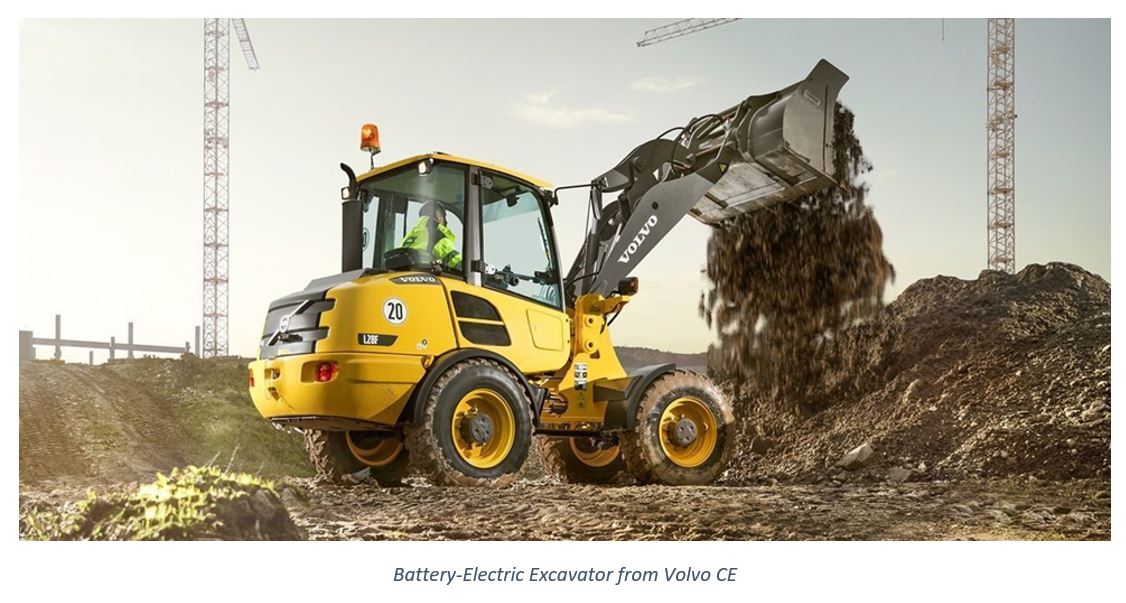

Electrification is one of the most significant trends in transport today. Lower maintenance costs, more efficient operation, and zero tailpipe emissions among many other benefits have led to an accelerating adoption of electric vehicles (EVs) for road transport needs. Now, companies are finding that EVs can bring operational benefits in off-highway use cases in the construction, agriculture, and mining industries. In this post, I will be discussing the adoption of electric construction vehicles for urban operations.

Owing to higher energy density compared to gasoline, diesel is the standard for construction equipment. Combusting diesel releases deleterious pollutants into the air which have been proven to impact respiratory, cardiovascular, and neurological systems, as well as causing various forms of cancer. Emissions from road vehicles alone are thought to cause about 50,000 premature deaths per year in the United States.
This would be bad enough in a rural area, but emissions from urban worksites impact many more people in their vicinity. In fact, researchers in London have estimated construction equipment is responsible for around 7% of NOx, 14% of PM2.5, and 8% of PM10 pollution in that city. This is especially harmful near sensitive areas, such as schools and hospitals, as well as confined work sites inside tunnels and buildings. As the world continues to urbanize (UN predicts two-thirds of the world will live in cities by 2050), more construction projects will break ground in ever-denser population centers.
Equipment operators are also exposed to uncomfortable vibration, noise, and heat, in addition to the dangerous exhaust as part of their work. As societal awareness of environmental realities grows, firms are facing ramping pressure from NGOs, activist investors, and their communities at large. Even more pertinently, cities are taking their air quality (and noise level) seriously, with regulatory action in tow. London has instituted particle emission regulation that will impact construction equipment in the city, and the trend is only likely to grow.
Electric powertrains allow for zero emission operation, avoiding the air pollution that poisons urban areas. Exhaust-free construction would be a boon to local health. Without the heat, noise, vibration, and noxious air that diesel brings, an electric fleet would provide a far more comfortable and safer environment for work crews.
Depending on relative prices of electricity and diesel, electric propulsion could lower an operator’s energy cost. Furthermore, as EVs are simpler and use far fewer moving parts than diesels, electric construction vehicles should require less maintenance and downtime throughout their lifespans.
Project economics aside, increasingly restrictive air and noise regulation will soon begin to pressure construction firms towards cleaner equipment, and the positive PR this will bring can only help in a world of heightened scrutiny and environmentally conscious citizens, workers, and investors.
Manufacturers Komatsu, Caterpillar, and Volvo CE are all releasing electrified equipment, with Volvo announcing a full stop of diesel compact wheel loaders and excavator production in its near future.

There are a few options for charging electric construction vehicles. A powerful DC fast charger working at 350 kW could charge a 300 kWh battery in just under an hour. For day-time construction, overnight charging should not prove restrictive. For ‘round-the-clock’ work, OEMs may need to explore tethered power and fast in-field battery swap capabilities.
In the near and medium term, economic, political, and social drivers will push construction firms to look closely at electrifying their equipment. Though electrification will not make sense in all situations, construction is a trillion dollar industry in the United States alone, making any development like this an exciting story to watch going forward.

